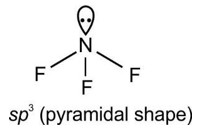Isostructural species are those which have the same shape and hybridisation. Among the given species identify the isostructural pairs.
(i) [NF3 and BF3 ]
(ii) [BF4 and NH4+ ]
(iii) [BCl3 and BrCl3]
(iv) [NH3 and NO3– ]
Isostructural species are those which have the same shape and hybridisation. Among the given species identify the isostructural pairs.
(i) [NF3 and BF3 ]
(ii) [BF4 and NH4+ ]
(iii) [BCl3 and BrCl3]
(iv) [NH3 and NO3– ]
-
1 Answer
-
This is a Multiple Choice Questions as classified in NCERT Exemplar
Ans: Option (ii)
In a molecular structure if a central atom has the same hybridization as the central atom of another molecular species, then the two structures are known as isostructural species.
(i) In NF3 the central nitrogen atom is sp3 hybridized and in BF3 the central boron atom is sp2 . So, these two molecules are not isostructural pairs.
(ii) In BF4 the central boron atom is sp3 hybridized and in NH4 + the central nitrogen atom is also sp3 So, these two molecules are identified as isostructural pairs.
(iii) In BCl3 the central boron atom is sp2 hybridized and in
...more
Similar Questions for you
He2 has zero bond order hence it does not exist.
The three fundamental laws of chemistry are - Law of Definite Proportions, Law of Conservation of Mass, and Law of Multiple Proportions.
The three types of chemical bonds are - ionic, metallic and covalent bonds. When the electrons transfer between the atoms, they form the Ionic bonds by producing charged ions that are attracted to each other. When atoms share electrons, covalent bonds are created. When metal atoms share a sea of delocalized electrons, metallic bonds get created.
Taking an Exam? Selecting a College?
Get authentic answers from experts, students and alumni that you won't find anywhere else
Sign Up on ShikshaOn Shiksha, get access to
- 66k Colleges
- 1.2k Exams
- 680k Reviews
- 1800k Answers


